Introductory Microeconomics
Description
The purpose of the course is to introduce students to the basic analytical principles and tools of modern economics, and to illustrate how these can be used to help understand observed economic phenomena, contemporary economic problems, and government economic policies.
The organization of the course reflects the division of the discipline into two main branches: microeconomics and macroeconomics. Microeconomics (Econ 110, and Econ 111) deals with the behavior of individual economic agents (households, firms and governments), the determination of prices and quantities in individual markets for commodities and resources, and with the role of governments in the functioning of the market system.
Macroeconomics (Econ 110B and Econ 112) studies the determination of aggregate economic quantities, such as the level of national output (and its rate of growth), the level of total employment and the rate of unemployment, and the average price level and rate of inflation. Macroeconomics also examines how government policies influence the aggregate behavior and performance of the economy.
Note: Check with the institution regarding start/end dates, prices, and delivery method. These may vary according to program, section, and/or semester.
Related Programs
Overview

- Institution: Queen's University
- Level: University
- Language: English
- Course Code: ECON111
- Delivery Method: Fully Online/Distance
Check with the institution regarding start/end dates, prices, and delivery method. These may vary according to program, section, and/or semester.
